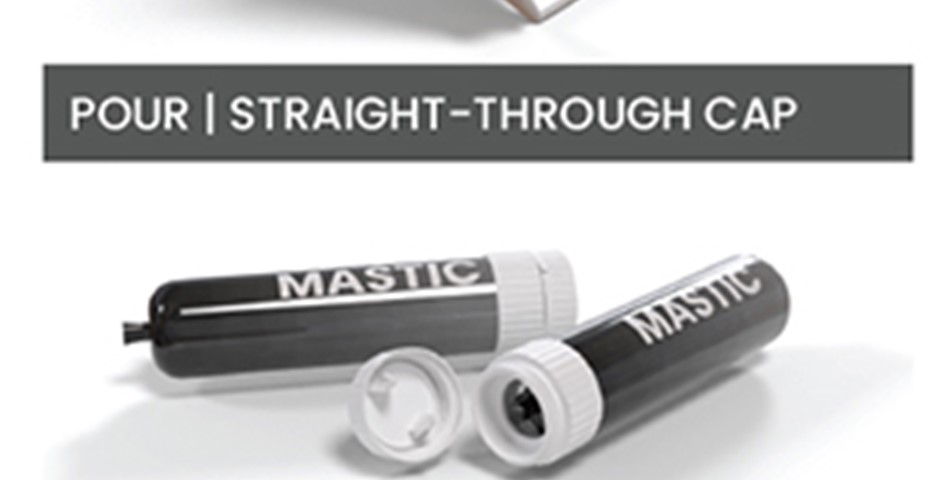Despite all the discussion and debate in society over reducing our waste and carbon footprint, sausage packages (also known as chubs) for adhesives and sealants continue to gain little support in the building industry—even though their reduced packaging and low waste factor represent a step change in sustainability. Quick math shows that a 10-oz sausage brings just 3% of the waste footprint of a 10-oz single-use plastic cartridge, representing a massive reduction.
How is it possible that the sausage could make such a difference? The foil film used in sausage manufacturing is much thinner (by 76%) than the extruded single-use plastic required to make tubes and cartridges, even while remaining tough and substantial enough to resist puncture and tearing. So what might keep people from switching to sausage packaging?
Usability Concerns
One limiting factor has traditionally been the lack of an elegant way to open and close sausages. However, the sustainable advantage of the sausage can be realized with a new design that combines the naked sausage with the open-and-close capabilities of a traditional container. Even when the plastic collar and cap required for this feature are taken into account, the building trade could reduce waste volume by 80% by switching to a sausage from a traditional cartridge.
Available caps include two styles of spout and six different applicator caps (i.e., caps that are also built-in specialized applicators for different products and applications), as illustrated in Figure 1. Since it obviates the need for additional tools, this is a convenience for consumers while also eliminating even more plastic use and associated landfill. Moreover, the collar and caps are made of recyclable plastic, so directing them to a recycling program still achieves a 97% reduction in waste.
Reducing Product Waste
Sausages do more than just reduce packaging waste. Because the sausage’s foil is designed to preclude air from entering the vessel as its contents are expelled, there is no premature drying out of the mastic—and hence no product waste.
This is a huge potential sustainability advantage for sealants and adhesives. A sampling of 750 spent cartridges and single-use plastic squeeze tubes destined for landfill shows that, on average, 43% of the mastic was still in the containers because it had hardened and become unusable. This is a relatively low figure; a survey completed in the Netherlands found over 60% cured mastic still in containers that had been thrown out.1
This dried and unusable product dramatically magnifies the waste footprint, increasing it by several times the volume of the packaging. Product managers often say, “We like the mastic drying out, because it forces the consumer to buy another unit.” While this might have passed for a reasonable line of thinking years ago in some circles, society has moved far beyond accepting such a short-sighted and wasteful perspective. We all need to be unified in our efforts to reduce waste.
Moreover, we can expect the industry to undergo increased regulatory pressure to improve its environmental standards. It is sound strategy to make a 97% reduction in waste (or even an 80% reduction) to anticipate and meet this pressure.
Cost Considerations
While corporate conscience may be onside for a significant sustainability step, adhesive and sealant manufacturers need to be mindful of both upstream and downstream costs. When factoring in fully loaded upstream and downstream costs, unit costs of the sausage easily enhance the bottom line.
From an upstream perspective, 96,000 empty plastic containers fill a 53-ft trailer, while the same output from foil or film takes up only a skid (see Figure 2). In addition, much more warehouse space is needed to store plastic containers during scheduled production.
Downstream, the waste removal costs are significant and rising. It is incumbent on all manufacturers to do an extensive and detailed analysis to determine this cost accurately, but it can be reasonably estimated that the disposal cost for containers will be 4-5 times greater than for sausages. In the future, further costs will eventually come in the form of a tax on single-use plastic containers, as well as, potentially, any other environmentally unfriendly features that raise red flags for regulators.
Sustainable Benefits
Sausages can easily be configured for sizes ranging from 1-32 oz; the diameter and length can change based on the desired volume of mastic. In addition, given the long history of sausage-type packaging in food-grade applications, with a variety of foils and film available, print options are unlimited. Retail presentation can be readily optimized by using color and continuous print or eye marks. From a utility point of view, with the innovation of sausages that can be opened and closed, new applications for mastics may be developed that might not have been previously considered.
If adhesive and sealant manufacturers perceive that their current packaging is not in the path of progress toward sustainability, they need to consider sausages as a better-performing packaging strategy. Advantages include:
- Improved seal for longer shelf life
- Virtual elimination of air, keeping the mastic fresh after opening; users can store whatever is unused for a future application, resulting in less product waste
- Ability to integrate any of a variety of applicators
- An 80% improvement in waste reduction, even with open/close capability in the form of a collar and cap
- Tamper-proof tab
- Controlled higher viscosity delivery system, making it easier for the end user to avoid expelling more than the amount required
How can the building industry lower its waste footprint and contribute to a greener economy? Molecular science is not required to make significant progress with waste management. Many simple, economically sound designs—like sausage packaging—can result in worthwhile progress.
Daniel McKenzie












